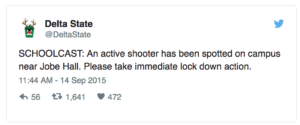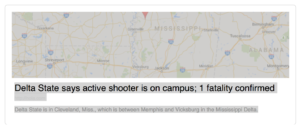
Backstory: Sitting in Grenada Nissan, my BlackBerry began to ring seemingly every second. Though I didn’t recognize the numbers, as an emergency contact for my nieces and nephews, I answered the first few calls. From screams of “What’s happening?” to “Who is this?” to “Is my child okay?”, my blanket response of “I’m sorry; you have the wrong number.” no longer sufficed, and I could no longer write off the moment as a sick joke of someone distributing my personal number. After checking one or two of the thousands of text messages that would immediately give my BlackBerry a run for its power, I knew something was bad wrong, and like the classic time jump scene in movies, my head and heart took my fears straight on to the campus of Delta State University.
After failed attempts to reach University Police and University Relations (I knew it was a long shot), I finally connected via text with a beloved friend on campus who responded two words: “campus shooter”. Subsequently, faculty locked in classrooms contacted me via BlackBerry Messenger to state what was now obvious – my number was notifying students and parents and anyone who had signed up for emergency alerts through the university’s crisis system. Admittedly in the moment, I became angered. Not because of my over-heating, but not over-worked BlackBerry or the disturbance of my day, but I could not stop thinking, “How could they let this happen?” I’d been gone from the university for 2 years at that point in time, but vividly remember the day my former director, university leadership, and myself sat around the table to begin putting together a solid crisis communications plan. Only second to the fear of loss of life, I couldn’t stop wondering how – did – this – happen?
Full of emotions, fears, and tears, I couldn’t do a single thing about what was happening. I wasn’t in a position to speak on behalf of the university anymore. However, parental instinct kicked in, and I got over it. I couldn’t NOT do anything. I remembered the campus had JUST hired a new Director of CommMark a couple of months ago who couldn’t be any more than a few days into on-boarding. I couldn’t blame her, but I could help the situation as much as I could from where I was. So, I crafted a copy/paste message to respond to text messages (or as many as I could) which simply read, “For updates, contact University Relations at 662…. or visit deltastate.edu.” As for the calls, I couldn’t answer them. Not out of emotions, but because I knew where the conversation would go, and legally, I couldn’t go there. So, to those missed numbers, I sent that same text message.

Today is the 2nd anniversary of Delta State University’s campus shooting. There’s a whole other set of emotions present, but there’s also a very simple message – If you are in higher ed comms or academia (period) and have not revisited your crisis communications plan, here are a few suggestions –
These 5 things are the tip of the iceberg as there is so much more to consider (and I would be glad to talk about it at length because it’s a critical and hard conversation though necessary), but these are 5 of the most important preparedness actions.
To wrap up this very emotional and informal post, just take campus shootings serious. At any given moment it can happen, and when it does happen, the university and its people become the only family those young adults (kids) have in that moment. The time, the effort, the patience, and the resources required to be as ready as possible… it’s worth it.
As with every life experience, we learn and we go forward building on and leading past the experience. This post isn’t to scrutinize Delta State University in any way; I’m still a member of the community and have a deep affinity for the school, but the experience itself is part of a greater conversation on how to keep the kids whose lives schools have been entrusted with, safe.



